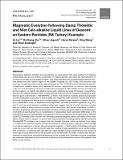| dc.contributor.author | Liu, Ze | |
| dc.contributor.author | Zhu, Di-Cheng | |
| dc.contributor.author | Jagoutz, Oliver E | |
| dc.contributor.author | Rezeau, Hervé | |
| dc.contributor.author | Wang, Qing | |
| dc.contributor.author | Eyuboglu, Yener | |
| dc.date.accessioned | 2021-10-01T14:41:22Z | |
| dc.date.available | 2021-10-01T14:41:22Z | |
| dc.date.issued | 2020-09 | |
| dc.date.submitted | 2019-09 | |
| dc.identifier.issn | 0022-3530 | |
| dc.identifier.issn | 1460-2415 | |
| dc.identifier.uri | https://hdl.handle.net/1721.1/132677 | |
| dc.description.abstract | Associations between tholeiitic and calc-alkaline arc magmatism with close spatial and temporal relationships can provide critical constraints on magma genesis and allow the reconstruction of subduction polarity at convergent margins. This study identifies two compositionally distinct intrusive series from the Yusufeli region in the Eastern Pontides arc, NE Turkey. The intrusive rocks from the Yusufeli intrusive complex were emplaced at 179–170 Ma and are dominated by the low- to medium-K tholeiitic series, with depleted Hf isotopic compositions. In contrast, the intrusive rocks from the Camlikaya intrusive complex were emplaced at 151–147 Ma and are characterized by the medium- to high-K calc-alkaline series, with relatively enriched Hf isotopic compositions. The Al-in-hornblende geobarometer reveals that the magmas of both intrusive complexes crystallized at upper crustal levels (∼150–250 MPa, ∼5–8 km). The presence of patchy-textured plagioclase and the widespread occurrence of coeval dykes and magmatic mafic enclaves indicate that the two intrusive complexes are derived from multiple magma pulses in open magmatic systems. The mineral crystallization order of amphibole and plagioclase, the trace elemental signatures (e.g. Sr/Y and Y), and rare earth element modeling collectively suggest that the Yusufeli intrusive complex was dominated by plagioclase and clinopyroxene fractionation with earlier plagioclase crystallization than amphibole, whereas the Camlikaya intrusive complex was dominated by the fractionation of amphibole accompanied by co-crystallization of plagioclase. Such significant differences in the fractionating mineral assemblages at comparable intrusion pressures can be attributed to different initial H₂O contents of the Yusufeli and Camlikaya parental magmas, which ultimately control their distinct liquid lines of descent. In accord with thermodynamic modeling results derived using the Rhyolite-MELTS software, we propose that the Yusufeli intrusive rocks are derived from damp (∼1–2 wt% H₂O) parental magmas formed dominantly by decompression melting of mantle wedge in a back-arc setting. In contrast, the wet parental magmas (>∼2 wt% H₂O) of Camlikaya intrusive rocks are more hydrous and formed through flux melting of suprasubduction-zone mantle wedge. This conclusion, combined with the back-arc basin related Jurassic sedimentary and structural records previously determined in the Southern Zone of the Eastern Pontides, indicates that the geochemical compositions and spatial relationship of the Yusufeli and Camlikaya intrusive complexes are preferably explained by the southward subduction of the Paleotethys oceanic lithosphere in the Early to Late Jurassic. | en_US |
| dc.description.sponsorship | National Science Foundation (Grant EAR-1552202) | en_US |
| dc.description.sponsorship | International Postdoctoral Exchange Fellowship Program (Award 2020028) | en_US |
| dc.language.iso | en | |
| dc.publisher | Oxford University Press (OUP) | en_US |
| dc.relation.isversionof | http://dx.doi.org/10.1093/petrology/egaa088 | en_US |
| dc.rights | Creative Commons Attribution-Noncommercial-Share Alike | en_US |
| dc.rights.uri | http://creativecommons.org/licenses/by-nc-sa/4.0/ | en_US |
| dc.source | Prof. Jagoutz | en_US |
| dc.title | Magmatic Evolution following Damp Tholeiitic and Wet Calc-alkaline Liquid Lines of Descent: an Eastern Pontides (NE Turkey) Example | en_US |
| dc.type | Article | en_US |
| dc.identifier.citation | Liu, Ze et al. "Magmatic Evolution following Damp Tholeiitic and Wet Calc-alkaline Liquid Lines of Descent: an Eastern Pontides (NE Turkey) Example." Journal of Petrology 62, 5 (September 2020): egaa088. © 2020 The Author(s) | en_US |
| dc.contributor.department | Massachusetts Institute of Technology. Department of Earth, Atmospheric, and Planetary Sciences | en_US |
| dc.relation.journal | Journal of Petrology | en_US |
| dc.eprint.version | Author's final manuscript | en_US |
| dc.type.uri | http://purl.org/eprint/type/JournalArticle | en_US |
| eprint.status | http://purl.org/eprint/status/PeerReviewed | en_US |
| dc.date.updated | 2021-09-30T15:00:47Z | |
| dspace.orderedauthors | Liu, Z; Zhu, D-C; Jagoutz, O; Rezeau, H; Wang, Q; Eyuboglu, Y | en_US |
| dspace.date.submission | 2021-09-30T15:00:49Z | |
| mit.journal.volume | 62 | en_US |
| mit.journal.issue | 5 | en_US |
| mit.license | OPEN_ACCESS_POLICY | |
| mit.metadata.status | Complete | en_US |
